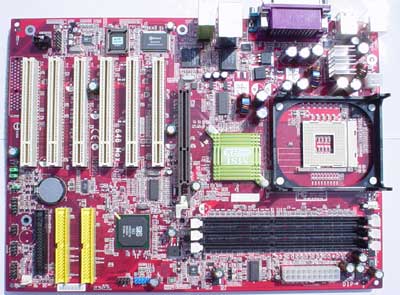
Original Link: https://www.anandtech.com/show/981
MSI 648 Max-F: SiS 648 Goes Mainstream
by Evan Lieb on September 4, 2002 1:38 PM EST- Posted in
- Motherboards
Having tested ABIT's SR7-8X and Shuttle's AS45GTR (both based on the SiS 648 chipset), we were eager to see how the MSI 648 Max-F would stack up. MSI is one of the first motherboard makers with a SiS 648-based motherboard that can be considered "tier-one". Other tier-one motherboard makers like ASUS and Gigabyte will soon have their 648 boards ready to go, and we'll have individual reviews of them when that time comes.
MSI's naming scheme for their SiS 648 series of motherboards is quite simple. The "F" at the end of "Max" indicates the addition of Gigabit technology. The MSI 648 Max-L, on the other hand, is the exact same motherboard as the "F" version we're reviewing today minus Gigabit (but it still comes with LAN). The MSI 648 Max is exactly the same as the "L" version minus LAN.
Anyway, knowing that the SiS 648 unofficially supports DDR400 memory, we were naturally eager to see if the MSI 648 Max-F could operate reliably and perform well with DDR400. However, MSI says that the 648 Max-F isn't meant to be run with DDR400 memory and that for top-notch reliability, DDR333 memory is the way to go. As you will see shortly, this is both true and false.
With the SiS 648 chipset finally starting to go mainstream, we take an in-depth look at MSI's 648 Max and see what it offers that no other motherboard can…
MSI 648 Max-F: Basic Features
|
Motherboard Specifications |
|
|
CPU
Interface
|
Socket-478
|
|
Chipset
|
SiS
648 North Bridge
SiS 963 South Bridge |
|
Bus
Speeds
|
100
- 200MHz (in 1MHz increments)
|
|
Core
Voltages Supported
|
up
to 1.60V in 0.025V increments
|
|
I/O
Voltages Supported
|
N/A
|
|
DRAM
Voltages Supported
|
up
to 2.8V in 0.1V increments
|
|
Memory
Slots
|
3
184-pin DDR DIMM Slots
|
|
Expansion
Slots
|
1
AGP 8X Slot
6 PCI Slots |
|
Onboard
RAID
|
N/A
|
|
Onboard
USB 2.0/IEEE-1394
|
USB2
Supported through South Bridge
|
|
Onboard
LAN
|
Broadcom
5702 Gigabit Ethernet
|
|
Onboard
Audio
|
Realtek
ALC650 6-channel AC'97
|
|
BIOS
Version Tested
|
1.0BC
|
As we normally do, we'll start off this review by looking at some of the more basic features of the MSI 648 Max motherboard.
The MSI 648 Max-F has a few nice features that you won't find on many other Pentium 4 motherboards. To start off with, we see that MSI decided to integrate a slightly different LAN chip than what we've become accustomed to seeing. MSI choose the Broadcom 5702 chip, which supports Gigabit technology. Not only does is this chip capable of 10/100 Mb/s transfer rates that most conventional LAN chips support, but it's also capable of up to 1000Mb/s transfer rates. The usefulness of Gigabit Ethernet on the 648 Max-F will be limited due to the relatively low adoption rate of Gigabit Ethernet.
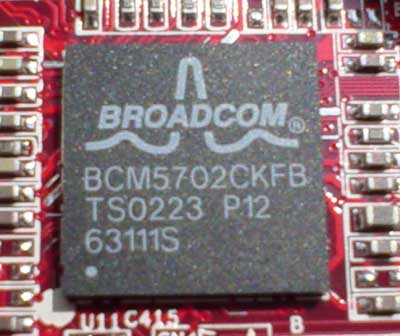
Moving on to the I/O ports, we see some not so unfamiliar items; 2 serial ports, 1 parallel port, 6 USB 2.0 ports (4 rear USB 2.0 ports and 2 front USB 2.0 ports), and the Gigabit LAN port (controlled by the Broadcom 5702 chip).

For sound you'll be using the Realtek ALC650 chip, which offers some of the best 6-channel audio you can get in an on-board solution.
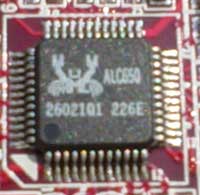
The MSI 648 Max-F also comes some nice accessories in addition to a good manual. The 648 Max-F manual is fairly detailed with lots of good info on memory and CPU specifications in addition to clear pictures. This manual should please the beginners out there, while advanced users probably won't be put off either. Some nice accessories that come with this board include a 2-port USB header and SPIDIF-out.
Finally we have the SiS 648 chipset itself, consisting of the SiS 648 North Bridge and SiS 963 South Bridge. As has been covered here before, the SiS 648 includes features such as:
1. AGP 3.0 (or AGP 8X) support.
2. 1GB/s I/O interconnect, aka MuTIOL.
3. Official Northwood-B (533MHz FSB) support.
4. Native support for USB 2.0, 1394a (FireWire), ATA133, Ethernet, and basic 6-channel sound.
5. Unofficial support for DDR400 memory (SiS648 only "officially" supports as high as DDR333 memory).
Board Layout
In general we were quite pleased with MSI's layout choices for the 648 Max-F.
We were happy to see that MSI placed the ATX 20-pin connector on the ideal side of the motherboard this time. We see that the ATX connector is located to the right of the 3 DIMM slots, almost at the very top right-hand portion of the motherboard. This greatly aids users that are constantly adding and/or removing items inside an ATX case, as the main ATX connector wires won't obstruct the process of removing said devices. We were also pleased to see the ATX12V connector located towards the top of the board, although it was at the not-so ideal left portion of the motherboard, next to the CPU socket.
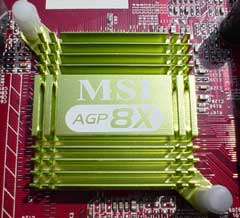
We have always liked passive heatsinks over any component of a motherboard, and the North Bridge is no exception. We see a light green passive heatsink over the SiS 648 North Bridge, which is located just below the CPU Socket as most North Bridges are. While not as effective as active cooling, there are a couple important benefits to having a passive heatsink; 1) it has 0% chance of failing whereas a fan might fail. And 2) passive heatsinks are completely silent whereas active cooling solutions can get quite loud.
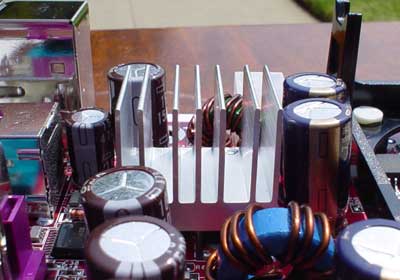
Passive cooling on the voltage regulators.
Out of all the layout choices MSI made with the 648 Max-F, we were disappointed that they didn't position the DIMM connectors a little further away from the AGP slot. We were barely able to unhinge our RAM from all 3 DIMM slots due to the fact that the bottom DIMM connectors touched the AGP card (we used a GeForce4 Ti4600). With a GeForce3 Ti200, we were able to extract RAM from one of the 3 DIMM slots without the AGP card getting in the way, but with larger cards like the GeForce4 Ti4600, we were unable to unhinge any RAM from any of the memory banks without the DIMM connectors hitting the AGP card, bending it at an angle.
Thankfully, MSI laid out the 648 Max-F so that we were able to fit all types of PCI cards in the 6 slots that were available; everything from USB cards to sound cards to network cards fit without issue, meaning nothing obstructed the installation/operation of a PCI card on the 648 Max-F.
BIOS Setup and Overclocking Features
MSI's implementation of the AMI BIOS offers an array of information, but not a whole lot tweaking options. We should note that we encountered cold boot issues with the MSI 648 Max-F where the system would randomly not start up after being shut down. We finally received a new BIOS from MSI, which fixed the initial cold boot issues. This latest BIOS was used to perform all benchmark runs, stress tests, and overclocking.

In the BIOS setup you're only able to adjust Vcore up to 1.6V (in .25V increments). This is a very low Vcore ceiling for serious overclockers, and probably not even high enough for semi-serious overclockers.

What's even worse is the fact that, when adjusting Vcore to the "Auto" setting (which is supposed to be the CPU's default Vcore, 1.5V), the actual Vcore as taken from PC Health in the BIOS reads between 1.42-1.47V, much lower than the actual default 1.5V of the 2.26GHz Northwood-B processor we used. Upon setting Vcore to its highest in the BIOS (1.6V), the actual Vcore was only as high as 1.568V. Clearly, the MSI 648 Max isn't the overclocker's board. Going along with the corporate user impression the board's features gave us, this isn't too surprising.
We were pleased that memory voltage (VDIMM) options were better, with 2.8V being the maximum VDIMM allowable (in .1V increments). However, it usually isn't necessary to raise VDIMM very high to get good overclocking results from your memory, so it's hardly a big deal to begin with.
The FSB is adjustable in 1MHz increments all the way up to 200MHz, which is much higher than most overclockers will be able to get out of their Northwood CPU's. However, the MSI 648 Max-F wasn't able to take advantage of its good FSB options; we were only able to overclock our 2.26GHz Northwood-B CPU to 145MHz FSB (~ 2.465GHz) on 1.6V (1.568V actual) using retail cooling (which includes the thermal pad). We've been able to get much higher FSB overclocks with this same processor and identical cooling on other motherboards, so we know the CPU isn't the limiting factor. We can safely conclude that the MSI 648 Max-F motherboard itself is at fault. If you remember back to our ABIT SR7-8X (SiS 648) review, we noticed a similar lack of overclocking potential from the SR7-8X, which allowed us to go no higher than 144MHz FSB using the exact same setup (same cooling, PSU, etc.).
While a bit premature (having only tested two different SiS 648 motherboards), we're beginning to suspect that SiS 648 motherboards aren't spectacular overclockers by nature. Of course, we'll have to wait and see, as ASUS and Gigabyte (among other mainboard companies) will be releasing SiS 648 motherboards very soon. One potential explanation is that these boards are optimized for their low cost and thus won't have much effort put into using higher quality components and trace optimizations that would normally allow the boards to operate significantly out of spec.
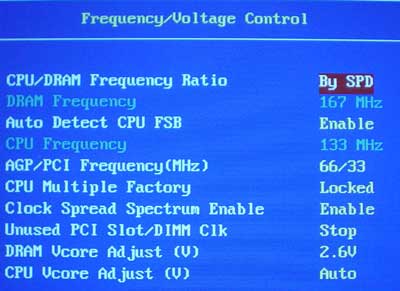
It was very pleasing to see MSI include an AGP/PCI lock option in the BIOS. As you can probably already guess, we were able to raise the FSB to 145MHz while keeping the AGP and PCI buses running at 66MHz/33MHz. Hardcore overclockers will love this feature. Unfortunately, they will not like the low overclocking potential of this motherboard, as a 200MHz overclock (2.26GHz to 2.465GHz) isn't too spectacular.
Stress Testing the MSI 648 Max-F
Stress testing the MSI 648 Max-F was pretty painless for the most part, although we did run into some interesting memory issues. At POST (just before we attempted to install Windows XP Pro), we were immediately greeted with a warning regarding the CPU:Memory settings. We were told to press the Delete key to enter the BIOS and change the CPU:Memory settings. This was puzzling at first because the CPU:Memory ratio was set to 4:5 (133MHz FSB:167MHz DRAM clock) and CAS Latency was set to 2.5 with "Fast" mode enabled and the Command Rate set to auto. These settings seemed fairly conservative, although pretty optimized for good performance. Therefore, we decided to ignore the initial warning and simply boot into Windows.
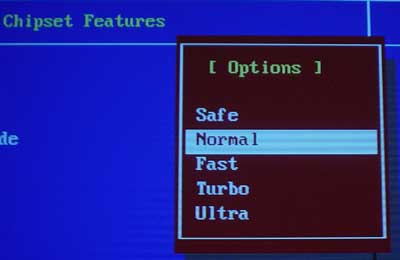
We were able to boot into Windows and run stress tests and benchmarks without issue for a while. However, the 648 Max-F wouldn't POST after restarting from Windows, which forced us to cold boot every time we needed to get back into Windows. Finally, we figured out that the initial CPU:Memory settings warning occurred because we had "Fast" mode enabled in the BIOS. We were disappointed that the 648 Max-F couldn't run DDR333 memory with "Fast" mode enabled, as it shouldn't be a big deal to begin with. But we set the memory to "Normal" mode anyway, with all other settings exactly the same, and never encountered the warning again.
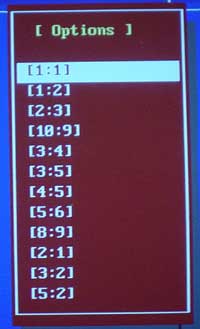 Oddly
enough, we also noticed that our benchmark scores went down the faster we
set the memory timing mode to; that is, switching from "Normal"
to "Fast" mode decreased scores by a couple percent, as did going
from "Fast" to "Turbo" mode. However, "Normal"
mode was faster than "Safe" mode, which is the slowest memory timing
setting available through the 648 Max-F's BIOS.
Oddly
enough, we also noticed that our benchmark scores went down the faster we
set the memory timing mode to; that is, switching from "Normal"
to "Fast" mode decreased scores by a couple percent, as did going
from "Fast" to "Turbo" mode. However, "Normal"
mode was faster than "Safe" mode, which is the slowest memory timing
setting available through the 648 Max-F's BIOS.
Finally, we decided to fully stress test the MSI 648 Max-F, and so we ran Prime95 for 48 hours straight with all 3 DIMMS filled with DDR333 memory at CL2.5, Command Rate at 1T, and in "Normal" mode. While we didn't see any issues crop up, we would have liked to have been able to run the memory in "Fast" mode without seeing performance go down. It's interesting to note that when we did run DDR333 in "Fast" mode, there weren't any stability issues (besides sporadic no-restart issue), the main problem was that performance went down by a percent or two.
The MSI 648 Max-F ran DDR400 memory fairly well though, especially considering that MSI claims this board isn't meant to run DDR400 memory at all (there are ratios in the BIOS that support this memory type however, and even higher in fact - see right).
In general, we were able to do pretty much anything we desired running one stick of Twinmos DDR400 memory (bank 2) with the 648 Max-F. However, we must mention that we had to set all our timings pretty conservatively; "Safe" mode was enabled, Command Rate was set to 2T, and CAS Latency was set to 2.5 (CL2.5 for DDR400 is actually quite good). Prime95 torture tests were run for 24 hours straight without issue using these settings. However, we encountered some problems completing certain SPECviewperf benchmark tests. Under 3DSMAX and Pro Engineer, we witnessed a couple of freezes. Eventually we were able to finish running both SPEC benchmarks, but we certainly weren't content with this problem. Granted, MSI claims the 648 Max-F isn't meant to be run at DDR400, so these issues are understandable.
The Test
|
Performance Test Configuration |
||
| Processor(s): |
Intel
Pentium 4 2.26B
|
|
| RAM: |
256MB Samsung DDR333 CAS2.5 module (M368L3223CTL-C (L) B3)
256MB Twinmos DDR400 CAS2.5 module |
|
| Hard Drive(s): |
Western Digital 120GB 7200 RPM
Special Edition (8MB Buffer)
|
|
| Bus Master Drivers: |
Latest SiS Drivers, VIA 4-in-1 v4.42, IAA v2.2 (845G, 845E, 850E)
|
|
| Video Card(s): |
NVIDIA
GeForce4 Ti 4600
|
|
| Video Drivers: |
NVIDIA
Detonator 30.82
|
|
| Operation System(s): |
Windows
XP Professional
|
|
The AnandTech Motherboard Testbed was Sponsored by Newegg. You can buy the components we used to test at www.newegg.com.
Content Creation & General Usage Performance
SYSMark has become a solid measurement of overall system performance since its induction into our benchmarking suite. Although the Internet Content Creation suite caters to more of a niche market, the Office Productivity tests are a perfect measurement of overall system performance in the applications all of us use on a daily basis.
The applications benchmarked include:
· Internet Content Generation: Adobe Photoshop® 6.01, Adobe Premiere® 6.0, Microsoft Windows Media Encoder 7.1, Macromedia Dreamweaver 4, and Macromedia Flash 5
· Office Productivity: Microsoft Word 2002, Microsoft Excel 2002, Microsoft PowerPoint 2002, Microsoft Outlook 2002, Microsoft Access 2002, Netscape Communicator® 6.0, Dragon NaturallySpeaking Preferred v.5, WinZip 8.0, and McAfee VirusScan 5.13.
For more information on the methodology and exactly what SYSMark does to generate these performance scores check out BAPCo's SYSMark 2002 Whitepaper
|
|
As you can see, there isn't too much difference between any of the competing solutions in either Internet Content Creation or Office Productivity. This isn't too unusual when you consider that all the motherboards tested (save the 850E) are based off chipsets that have been tweaked to run DDR333 memory for months now, which has cut down on the lead of the PC1066-equipped ASUS P4T533-C board.
Also, if you remember back to our first DDR400 review, you'd know that the Shuttle AS45GTR, VPSD P4PB 400, and Soltek 85ERV were all unable to operate well enough to take down any benchmark scores with DDR400 memory. Unfortunately, this fact hasn't changed since then. Perhaps with future BIOS updates these boards will be able to run DDR400 well enough to complete our benchmark suite.
Quake III Arena Performance
Quake III's usefulness as a gaming benchmark has diminished mostly because of the fact that we're able to consistently produce frame rates over 300 fps at 1024x768 with the fastest video cards. But as the benchmark becomes less GPU limited, it becomes a perfect candidate for CPU and platform tests such as this one.
|
No surprises here, the RDRAM-powered ASUS P4T533-C is the fastest of the bunch. However, its lead is diminishing over time as Taiwanese chipset makers are introducing faster and faster products more rapidly than ever.
Unreal Tournament 2003 Performance - High Detail
We introduced the latest Unreal Tournament 2003 benchmark in our GPU Shootout article a few weeks back and we're continuing to use it as an example of a next-generation game test.
We benchmarked under two different levels and detail settings; the first was DM-Antalus with High Detail settings, an overly GPU bound benchmark, and the second was DM-Asbestos with Medium Detail settings.
| Gaming
Performance Unreal Tournament 2003 - DM-Antalus 640x480 High Detail |
|||||||||||||
|
| Gaming
Performance Unreal Tournament 2003 - DM-Antalus 1024x768 High Detail |
|||||||||||||
|
High End Workstation Performance - SPEC Viewperf 7.0
The latest version of SPEC Viewperf proves to be an excellent stress test for memory bandwidth and overall platform performance as you're about to see. The benchmarks included version 7 of the benchmark suite are:
3ds max (3dsmax-01)
Unigraphics (ugs-01)
Pro/Engineer (proe-01)
DesignReview (drv-08)
Data Explorer (dx-07)
Lightscape (light-05)
For more information on the tests run visit SPEC's page on the new Viewperf benchmark.
|
|
|
High End Workstation Performance (continued)
| High
End Workstation Performance SPEC Viewperf 7.0 - LIGHT-05 |
|||||||||||||
|
| High
End Workstation Performance SPEC Viewperf 7.0 - ProE-01 |
|||||||||||||
|
| High
End Workstation Performance SPEC Viewperf 7.0 - UGS-01 |
|||||||||||||
|
Final Words
The MSI 648 Max-F motherboard is an impressive piece of silicon for the most part. DDR333 performance and stability were fairly good, despite the performance issues with running memory in "Fast" mode. We were happy to see that DDR400 memory helped to increase scores a little bit over its DDR333 performance numbers. Even though DDR400 stability was only mediocre, it's not too bad for a board that's not intended to run this type of memory.
MSI also tells us that their next generation SiS 648 Pentium 4 motherboard (SiS 648DX) will be able to run DDR400 memory without issue. In fact, MSI claims that by the time they release their 648DX motherboard, JEDEC will have ratified a DDR400 specification. This is certainly exciting, as DDR400 performance and stability should improve quite significantly.
The debut price for the MSI 648 Max-F is supposed to hover between $95-100. This is a very good price, as the 648 Max-F brings lots of good features in addition to solid performance and stability. The inclusion of Gigabit Ethernet support in a sub-$100 motherboard is a very interesting feature, especially for corporate markets or in file server situations.
Stay tuned for more SiS 648 coverage in the future, in addition to KT400 and nForce2 reviews very soon.

